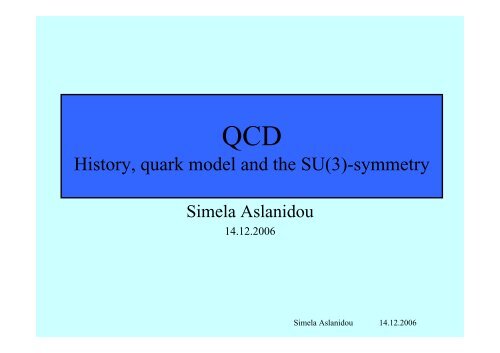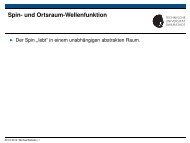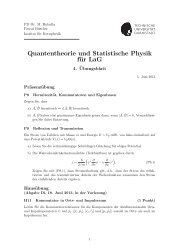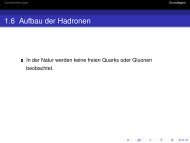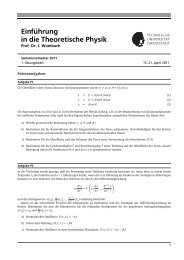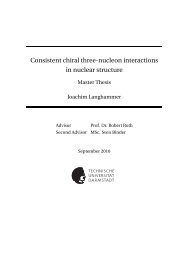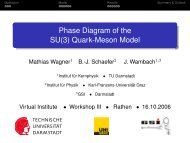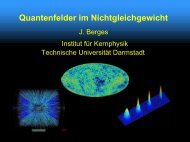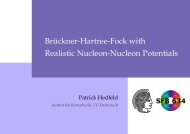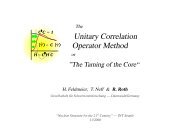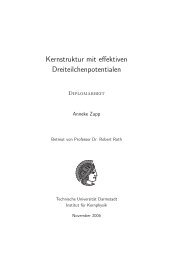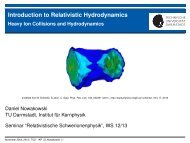History, quark model and the SU(3)-symmetry
History, quark model and the SU(3)-symmetry
History, quark model and the SU(3)-symmetry
You also want an ePaper? Increase the reach of your titles
YUMPU automatically turns print PDFs into web optimized ePapers that Google loves.
QCD<br />
<strong>History</strong>, <strong>quark</strong> <strong>model</strong> <strong>and</strong> <strong>the</strong> <strong>SU</strong>(3)-<strong>symmetry</strong><br />
Simela Aslanidou<br />
14.12.2006<br />
Simela Aslanidou 14.12.2006
Contents<br />
• development <strong>and</strong> motivation for <strong>the</strong> foundation<br />
of QCD<br />
• concepts<br />
• <strong>the</strong> <strong>SU</strong>(3)-colour group<br />
Simela Aslanidou 14.12.2006
<strong>History</strong><br />
• up to <strong>the</strong> beginning of <strong>the</strong> 20th century <strong>the</strong><br />
common view in physics was that <strong>the</strong><br />
Coulomb-force is responsible for <strong>the</strong> formation<br />
of atoms.<br />
• with <strong>the</strong> discovery of <strong>the</strong> neutron it became<br />
clear, that <strong>the</strong>re must be an unknown<br />
interaction “gluing” <strong>the</strong> nucleons in <strong>the</strong> core<br />
toge<strong>the</strong>r.<br />
• Quantumchromodynamics (QCD) was<br />
established much later but this was <strong>the</strong><br />
beginning.<br />
Simela Aslanidou 14.12.2006
<strong>History</strong><br />
• with <strong>the</strong> development of particle accelerators<br />
in <strong>the</strong> 1940´s <strong>and</strong> 1950´s a large number of<br />
particles was discovered, called <strong>the</strong><br />
“particle-zoo”.<br />
• great efforts have been made in order to<br />
classify <strong>the</strong> “zoo” according to simple<br />
principles<br />
Simela Aslanidou 14.12.2006
<strong>History</strong><br />
• 1950´s<br />
Robert Hofstadter performed elastic electronproton-scattering<br />
experiments to study <strong>the</strong><br />
structure of protons<br />
protons are not pointlike<br />
Simela Aslanidou 14.12.2006
<strong>History</strong><br />
• Murray Gell-Mann <strong>and</strong> Yuval Ne´eman<br />
postulated in 1964 that hadrons can be<br />
constructed from a number of fundamental<br />
particles called '<strong>quark</strong>s'.<br />
• almost at <strong>the</strong> same time George Zweig<br />
proposed <strong>the</strong> same idea <strong>and</strong> he coined <strong>the</strong><br />
fundamental particles 'aces'.<br />
Simela Aslanidou 14.12.2006
<strong>History</strong><br />
• both, Gell-Mann <strong>and</strong> Zweig, chose <strong>the</strong><br />
<strong>SU</strong>(3)-<strong>symmetry</strong> (flavour)group <strong>the</strong>ory to<br />
organise <strong>the</strong> increasing number of discovered<br />
particles.<br />
• <strong>the</strong>y made <strong>the</strong>ir predictions on <strong>the</strong> basis of <strong>the</strong><br />
known baryon <strong>and</strong> meson octets.<br />
• in <strong>the</strong>ir <strong>the</strong>ory of <strong>SU</strong>(3)-<strong>symmetry</strong> (flavor)<br />
<strong>the</strong>y could organize all known hadrons as<br />
states of three different constituents.<br />
Simela Aslanidou 14.12.2006
<strong>History</strong><br />
In <strong>the</strong> 1960´s experiments were performed at<br />
SLAC in order to obtain information on <strong>the</strong><br />
structure <strong>and</strong> <strong>the</strong> substructure of hadrons<br />
assuming that <strong>the</strong>y are made of constituents <strong>and</strong><br />
not fundamental particles.<br />
Simela Aslanidou 14.12.2006
<strong>History</strong><br />
• <strong>the</strong> method of <strong>the</strong> experiments at SLAC was<br />
<strong>the</strong> same as Ru<strong>the</strong>rford had used in his<br />
experiments to explore <strong>the</strong> structure of an<br />
atom. In case of hadrons lepton-hadronscattering<br />
was a suitable probe.<br />
• <strong>the</strong> idea was to apply a beam of structureless<br />
particles (leptons) at high energy <strong>and</strong> thus high<br />
momentum transfer to obtain a high space-time<br />
resolution.<br />
• this process is called <strong>the</strong> deep-inelastic<br />
electron-proton scattering.<br />
Simela Aslanidou 14.12.2006
Concepts<br />
• to probe <strong>the</strong> structure of a particle one has to<br />
measure <strong>the</strong> cross-section. If we want to<br />
explore <strong>the</strong> structure of a hadron we use<br />
structureless pointlike projectiles like leptons.<br />
• if <strong>the</strong> recoil effect is neglected <strong>and</strong> <strong>the</strong> target<br />
particle is assumed to be pointlike <strong>the</strong><br />
differential cross-section is given by <strong>the</strong> Mott-<br />
Formula<br />
dσ<br />
dΩ<br />
( )<br />
Mott<br />
=<br />
4Z<br />
2<br />
α<br />
2<br />
( )<br />
qc<br />
hc<br />
4<br />
2<br />
E′<br />
2<br />
cos<br />
θ<br />
2<br />
Simela Aslanidou 14.12.2006<br />
2
Concepts<br />
The proton is an extended object, so <strong>the</strong><br />
differential cross-section for <strong>the</strong> elastic scattering<br />
is given by <strong>the</strong> Rosenbluth-formula<br />
dσ<br />
⎛ dσ<br />
=<br />
⎞<br />
⎜ ⎟<br />
dΩ<br />
⎝dΩ⎠<br />
Mott<br />
⎡<br />
⎢G<br />
⎢<br />
⎣<br />
2<br />
M<br />
( 2<br />
Q )<br />
2<br />
Q<br />
2M<br />
2<br />
tan<br />
θ G<br />
+<br />
2<br />
( 2)<br />
2<br />
+ ( 2<br />
Q G Q )<br />
1+<br />
Q<br />
GM <strong>and</strong> GE are <strong>the</strong> magnetic <strong>and</strong> electric form<br />
factors respectively.<br />
2<br />
2<br />
E<br />
M<br />
⋅<br />
Q<br />
Simela Aslanidou 14.12.2006<br />
2<br />
4M<br />
2<br />
2<br />
4M<br />
2<br />
⎤<br />
⎥<br />
⎥<br />
⎦
Concepts<br />
• in electron-proton scattering experiments <strong>the</strong><br />
electrons are relativistic <strong>and</strong> <strong>the</strong> process is<br />
e +<br />
p → e′<br />
+<br />
• for <strong>the</strong> kinematics we use <strong>the</strong> four-momentum<br />
<strong>and</strong> <strong>the</strong> energy-momentum relation leads to <strong>the</strong><br />
invariant mass<br />
x<br />
Simela Aslanidou 14.12.2006
Concepts<br />
invariant mass<br />
W²<br />
c²<br />
= P + q ²<br />
W<br />
=<br />
( )<br />
invariant<br />
=<br />
mass<br />
M²<br />
c²<br />
• elastic scattering<br />
= W → 2M<br />
• inelastic scattering<br />
><br />
M → 2<br />
;<br />
+<br />
2Pq<br />
ν<br />
M ν − Q²<br />
=<br />
=<br />
W Mν<br />
− Q²<br />
><br />
+<br />
0<br />
q²<br />
Pq<br />
M<br />
0<br />
=<br />
M²<br />
c²<br />
+ 2Mν<br />
−<br />
Simela Aslanidou 14.12.2006<br />
Q²
Inelastic scattering<br />
The differential cross section is now given by<br />
2<br />
⎛ σ ⎞ ⎛ dσ<br />
⎞<br />
⎜<br />
⎟ = ⎜ ⎟<br />
⎝ dΩdE′<br />
⎠ ⎝ dΩ<br />
⎠<br />
d 2<br />
Mott<br />
⎡ ( 2 ) ( 2 ) θ⎤<br />
⎢<br />
W2<br />
Q , ν + 2W1<br />
Q , ν tan<br />
⎥<br />
⎣<br />
2⎦<br />
with W1, W2 <strong>the</strong> structure functions of <strong>the</strong><br />
hadron <strong>and</strong> ν=Pq/M <strong>the</strong> energy transfer.<br />
Simela Aslanidou 14.12.2006
Inelastic scattering<br />
Displaying <strong>the</strong> ratio<br />
d²<br />
σ<br />
dΩdE′<br />
⎛ dσ<br />
⎞<br />
⎜ ⎟<br />
⎝ dΩ<br />
⎠<br />
Mott<br />
as a function of <strong>the</strong> invariant mass shows an<br />
unexpected behaviour for a pointlike<br />
particle as <strong>the</strong>re is only a small dependence in Q².<br />
Simela Aslanidou 14.12.2006
Inelastic scattering<br />
Electron-proton-scattering:<br />
cross-sections for inelastic<br />
scattering for different<br />
invariant masses in<br />
comparison with elastic<br />
scattering<br />
Simela Aslanidou 14.12.2006
Inelastic scattering<br />
d²<br />
σ<br />
dΩdE′<br />
⎛ dσ<br />
⎞<br />
⎟<br />
⎝dΩ<br />
⎠<br />
• <strong>the</strong> ratio ⎜ is independent from Q²<br />
lepton is scattered on a pointlike object<br />
• hadrons are extended objects<br />
<strong>the</strong>y must have pointlike constituents<br />
Mott<br />
Simela Aslanidou 14.12.2006
Bjorken scaling<br />
Structure-Function<br />
F2 as function of <strong>the</strong><br />
Bjorken Variable x<br />
here called ξ for<br />
different Q² values.<br />
2<br />
x : = Q 2Mν<br />
is <strong>the</strong> additive term<br />
from <strong>the</strong> invariant<br />
mass<br />
Simela Aslanidou 14.12.2006
Quarks<br />
Existence of Quarks<br />
<strong>the</strong>re is empirical evidence since <strong>the</strong> momentum<br />
transfer realised at SLAC was much larger than<br />
<strong>the</strong> nucleon-mass<br />
Q²>>M²<br />
this result is interpreted at <strong>the</strong> following way:<br />
<strong>the</strong> nucleon must have a substructure of<br />
quasi-free, point-like particles.<br />
Simela Aslanidou 14.12.2006
Quark <strong>model</strong><br />
• <strong>quark</strong>s come in 6 flavours<br />
up, down, strange, charm, bottom top,<br />
<strong>the</strong>se are <strong>the</strong> six different kinds of <strong>quark</strong>s<br />
• according to <strong>the</strong> regularity of <strong>the</strong> leptons<br />
<strong>quark</strong>s show <strong>the</strong> same family structure<br />
⎛<br />
⎜<br />
⎝<br />
u<br />
d<br />
⎞<br />
⎟<br />
⎠<br />
,<br />
⎛<br />
⎜<br />
⎝<br />
c<br />
s<br />
⎞<br />
⎟<br />
⎠<br />
,<br />
⎛ t ⎞<br />
⎜ ⎟<br />
⎝b<br />
⎠<br />
m<br />
m<br />
m<br />
u<br />
s<br />
b<br />
=<br />
1,<br />
5 to 4 MeV<br />
=<br />
=<br />
80 to130<br />
4.<br />
1 to 4.<br />
4<br />
MeV<br />
GeV<br />
m<br />
m<br />
m<br />
= 4 to 8 MeV<br />
= 1.<br />
15 to1.<br />
35 GeV<br />
= ( 174.<br />
3 ± 5.<br />
1)GeV<br />
Simela Aslanidou 14.12.2006<br />
d<br />
c<br />
t
Quark <strong>model</strong><br />
Problems<br />
• non-observation of isolated <strong>quark</strong>s<br />
• discrepancy between predicted <strong>and</strong><br />
experimental data on cross-sections<br />
• problem in constructing baryon wave functions<br />
(violation of <strong>the</strong> Pauli principle)<br />
Simela Aslanidou 14.12.2006
Quark <strong>model</strong><br />
Most of <strong>the</strong> difficulties can be resolved by<br />
introduction of a new quantum number called<br />
colour.<br />
Simela Aslanidou 14.12.2006
Necessity of <strong>the</strong> colour<br />
Quarks are required to be fermions with spin ½<br />
<strong>and</strong> according to <strong>the</strong> Pauli principle <strong>the</strong>y cannot<br />
occupy <strong>the</strong> same state.<br />
The quantum state has to be antisymmetric with<br />
respect to <strong>the</strong> exchange of all quantum numbers<br />
of <strong>the</strong> <strong>quark</strong>s.<br />
Simela Aslanidou 14.12.2006
Necessity of <strong>the</strong> colour<br />
Example : pion-proton resonance Δ ++<br />
3<br />
charge Q=2, isospin I = <strong>and</strong> strangeness S=0<br />
2<br />
3<br />
+ +<br />
Δ , J = 3<br />
2<br />
= u ↑ u ↑ u ↑<br />
is symmetric under exchange in contradiction<br />
to <strong>the</strong> Pauli principle<br />
Simela Aslanidou 14.12.2006
Colour<br />
• in 1965 O.W.Greenberg introduced <strong>the</strong> property of<br />
colour charge.<br />
• arbitrary denomination to assign an additional<br />
quantum number for which <strong>the</strong> state is antisymmetric:<br />
3<br />
2<br />
Δ = = ε ↑ ↑<br />
+ + k j i<br />
,<br />
J3<br />
ijk u u u<br />
εijk is <strong>the</strong> total antisymmetric tensor <strong>and</strong> <strong>the</strong> indices<br />
represent <strong>the</strong> colour<br />
↑<br />
Simela Aslanidou 14.12.2006
Colour<br />
• idea:hadrons are colour-neutral. Each <strong>quark</strong><br />
carries colour (red, blue, green) such that <strong>the</strong>ir<br />
combination gives white<br />
• in <strong>the</strong> case of <strong>the</strong> mesons made of <strong>quark</strong>anti<strong>quark</strong>-pair,<br />
<strong>the</strong> anti<strong>quark</strong> carries <strong>the</strong><br />
complementary colour<br />
Simela Aslanidou 14.12.2006
Colour<br />
The additive<br />
colour <strong>model</strong><br />
Simela Aslanidou 14.12.2006
Name<br />
up<br />
down<br />
charm<br />
strange<br />
top<br />
bottom<br />
Quantum numbers of Quarks<br />
Charge<br />
+2/3e<br />
-1/3e<br />
+2/3e<br />
-1/3e<br />
+2/3e<br />
-1/3e<br />
Isospin I<br />
1/2<br />
1/2<br />
0<br />
0<br />
0<br />
0<br />
Iz<br />
+1/2<br />
-1/2<br />
+1/2<br />
-1/2<br />
+1/2<br />
-1/2<br />
charm<br />
0<br />
0<br />
+1<br />
0<br />
0<br />
0<br />
strangeness<br />
+1<br />
Simela Aslanidou 14.12.2006<br />
0<br />
0<br />
0<br />
0<br />
0<br />
colour<br />
r, g, b<br />
r, g, b<br />
r, g, b<br />
r, g, b<br />
r, g, b<br />
r, g, b
Quark <strong>model</strong><br />
• why are <strong>the</strong>re three flavours (at least in <strong>the</strong> beginning)<br />
<strong>and</strong> three colours?<br />
π02γ decays<br />
e + + e- The factor of three appears<br />
- annihilation}<br />
Simela Aslanidou 14.12.2006
Quark <strong>model</strong><br />
e + e--Annihilation At high energies electrons <strong>and</strong> positrons<br />
annihilate into hadrons<br />
e + + e-hadrons Simela Aslanidou 14.12.2006
Simela Aslanidou 14.12.2006<br />
Quark <strong>model</strong><br />
Cross section<br />
More common<br />
( ) ∑<br />
πα<br />
=<br />
→<br />
σ<br />
−<br />
+<br />
f<br />
N<br />
i<br />
i<br />
c<br />
²<br />
Q<br />
N<br />
s<br />
3<br />
²<br />
4<br />
hadrons<br />
e<br />
e<br />
( )<br />
²<br />
Q<br />
N<br />
s<br />
3<br />
4<br />
hadrons<br />
e<br />
e<br />
R<br />
f<br />
N<br />
i<br />
i<br />
c ∑<br />
=<br />
πα<br />
→<br />
σ<br />
=<br />
−<br />
+<br />
3<br />
1<br />
Q<br />
3<br />
2<br />
Q<br />
3<br />
1<br />
Q<br />
3<br />
2<br />
Q<br />
3<br />
1<br />
Q<br />
3<br />
2<br />
Q<br />
<strong>quark</strong>s<br />
of<br />
charge<br />
Q<br />
colours<br />
of<br />
number<br />
N<br />
4<br />
e<br />
bottom<br />
top<br />
strange<br />
charm<br />
down<br />
up<br />
i<br />
i<br />
2<br />
−<br />
=<br />
=<br />
−<br />
=<br />
=<br />
−<br />
=<br />
=<br />
=<br />
=<br />
π<br />
=<br />
α
Ratio of <strong>the</strong> cross section<br />
Simela Aslanidou 14.12.2006
Ratio of <strong>the</strong> cross section<br />
Comparison of R with experimental data<br />
Energy=
Gluons<br />
ano<strong>the</strong>r experimental result from<br />
deep-inelastic electron-proton scattering was,<br />
that <strong>quark</strong>s only carry 50% of <strong>the</strong> momentum in<br />
<strong>the</strong> proton<br />
<strong>the</strong>re must be o<strong>the</strong>r constituents called<br />
“gluons”<br />
Simela Aslanidou 14.12.2006
Gluons<br />
• gluons are <strong>the</strong> gauge bosons of <strong>the</strong> strong<br />
interaction<br />
• gluons are <strong>the</strong> force carriers between <strong>quark</strong>s.<br />
• gluons are responsible for <strong>the</strong> <strong>quark</strong><br />
confinement.<br />
Simela Aslanidou 14.12.2006
Gluons<br />
gluons carry colour <strong>and</strong> anticolour at <strong>the</strong> same<br />
time<br />
gluons interact with each o<strong>the</strong>r (in<br />
contrast to photons)<br />
a) a <strong>quark</strong> radiates a gluon ; b) a gluon splits into a <strong>quark</strong>-anti<strong>quark</strong> pair<br />
c) three-gluon-interaction ; d) four-gluon-interaction<br />
Simela Aslanidou 14.12.2006
<strong>SU</strong>(N)<br />
• group of <strong>the</strong> non-abelian Lie-Algebra.<br />
• group of unitary NxN matrices with detU=±1<br />
<strong>and</strong> N²-1 parameters.<br />
• <strong>the</strong> N²-1 dimensional space is formed by <strong>the</strong><br />
N²-1 generators of <strong>the</strong> Algebra.<br />
Simela Aslanidou 14.12.2006
<strong>SU</strong>(3)<br />
The algebra is generated by <strong>the</strong> 8 Gell-Mann<br />
matrices λi , i=1,...,8.<br />
Define<br />
1<br />
Ti = λ<br />
2<br />
i<br />
The algebra satisfy <strong>the</strong> commutation relations<br />
[ T ] i,<br />
Tj<br />
=<br />
ifijkTk<br />
Simela Aslanidou 14.12.2006
<strong>SU</strong>(3)<br />
Why <strong>SU</strong>(3)-flavour?<br />
With <strong>the</strong> <strong>SU</strong>(3)-flavour it is possible to construct<br />
all hadron states from <strong>the</strong> fundamental triplet.<br />
Simela Aslanidou 14.12.2006
Ladder Operators<br />
Define <strong>the</strong> ladder operators T±, U±, V±<br />
(± st<strong>and</strong>s for step-up/step-down operator)<br />
Fˆ Fˆ Fˆ Vˆ Fˆ Fˆ Tˆ = ±<br />
±<br />
= 1 ± i 2 ;<br />
± = 4 ± i 5 ; Û±<br />
Applying <strong>the</strong> operators to <strong>the</strong> hadron states steps<br />
up or steps down <strong>the</strong> states <strong>and</strong> <strong>the</strong> multiplet can<br />
be constructed.<br />
Simela Aslanidou 14.12.2006<br />
6<br />
Fˆ i<br />
7
The Baryon-Oktet<br />
Start from <strong>the</strong><br />
fundamental triplet <strong>and</strong><br />
applying <strong>the</strong> ladder<br />
operators leads to <strong>the</strong><br />
states of a multiplet as it is<br />
shown in <strong>the</strong> figure for <strong>the</strong><br />
example of <strong>the</strong> baryon octet<br />
Simela Aslanidou 14.12.2006
<strong>SU</strong>(3)c<br />
• strong interaction is governed by <strong>the</strong> colour<br />
<strong>and</strong> not by <strong>the</strong> flavour.<br />
• two fundamental triplets<br />
colour ci , I=1,2,3 ;<br />
complementary colour c<br />
i , i=1,2,3<br />
Simela Aslanidou 14.12.2006
References<br />
T. Muta, World Scientific Lectures Notes in Physics-Vol 57<br />
„Foundations of quantumchromodynamics“<br />
W. Greiner, Theoretische Physik B<strong>and</strong> 6<br />
„Symmetrien“<br />
W. Greiner, Theoretische Physik B<strong>and</strong> 10<br />
„Quantenchromodynamik“<br />
B. Povh, K. Rith, C. Scholz, F. Zetsche<br />
„Teilchen und Kerne“<br />
G. Musiol, J. Ranft, R. Reif, D. Seeliger<br />
„Kern- und Elementarteilchenphysik“<br />
G. Zweig, Cern-Libraries, Geneva<br />
„An <strong>SU</strong>(3) Model of strong interaction <strong>symmetry</strong> <strong>and</strong> ist breaking“<br />
http://www.personal.uni-jena.de<br />
M. E. Peskin, PiTP Summer School, July 2005<br />
Simela Aslanidou 14.12.2006
THE END<br />
Simela Aslanidou 14.12.2006


